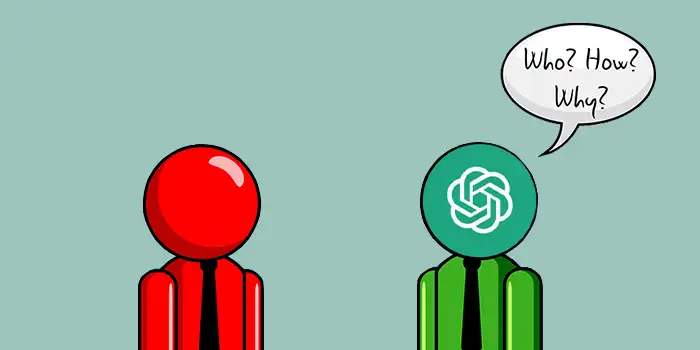ChatGPT is a super smart language mode that it can almost think and reason as we do. I’ve been exploring this AI chatbot ever since it was launched, and I’ve been captivated somehow by its reasoning abilities. I really sensed something special about this AI ever since I first used it.
ChatGPT exhibits reasoning abilities to a certain extent. This AI chatbot employs statistical patterns and contextual understanding to generate coherent responses. However, it lacks genuine cognitive reasoning as humans possess. Its responses are based on learned patterns rather than deep comprehension making it a limitation in its ability to truly reason.
In this article, you’ll learn:
Is ChatGPT Capable of Reasoning?
Okay, so ChatGPT is a super smart AI chatbot that can talk and answer questions like a real person. It can also understand what you’re saying and give you responses that make sense. But here’s the thing, ChatGPT’s way of reasoning is a bit different from how humans do it.
Do you know how we utilize our brains to analyze things and establish logical connections when we think and reason? Well, ChatGPT doesn’t have a real brain like us. Instead, it uses something called statistical patterns and context to figure out what to say.
What does that mean? It means that ChatGPT has read a lot of words and learned from them. It knows how words are usually used together, and it can guess what might come next in a sentence.
As a result, each time you ask a question or give a prompt, it looks for patterns in the words you previously used and utilizes those patterns to generate a response.
But there’s a catch out here, ChatGPT doesn’t really understand the meaning behind the words. It’s like a really good guesser, but it doesn’t have the same kind of deep understanding that humans have. It can’t think deeply or make connections the way we do.
Every time you use this AI chatbot, you can see that it is very helpful in giving us information and helping us with simple tasks.
For example, it can answer questions about famous people or even help students with their homework. But when it comes to more complex problems or understanding feelings, it can struggle at times. It might give answers that sound right, but they might not be truly thoughtful or accurate.
I know ChatGPT has been so amazing ever since it was launched because it can almost mimic human-like reasoning. But you need to remember that it’s based on learned patterns and not real understanding. We still need real human brains to tackle that really tricky stuff and make deep connections.
Understanding ChatGPT’s Reasoning Abilities
ChatGPT’s reasoning abilities are an essential aspect of its language understanding and generation capabilities. Even though it does not possess true comprehension or cognition, ChatGPT utilizes various techniques to mimic reasoning and generate coherent responses.
Here’s an explanation of ChatGPT’s reasoning abilities based on my research:
1. Pattern Recognition
ChatGPT really excels in recognizing patterns. You know what patterns are, right? Like when you see a sequence of things that repeat or follow a certain order. Well, ChatGPT does that too, but with words!
This AI chatbot knows how to read lots and lots of words, and it starts to notice how they fit together. It looks for words that often appear near each other and figures out the patterns.
So every time you ask or prompt ChatGPT, it looks for similar patterns it learned before and uses them to come up with an answer.
2. Information Retrieval
ChatGPT has access to a vast pre-training knowledge base derived from multiple sources. This means that it can retrieve relevant information from this knowledge base to support its reasoning process.
So what ChatGPT does is look through all the words it has learned before to find the best answer. It’s like searching through a big library of information in its computer brain.
So, when you seek help from ChatGPT, you’re also like finding the right book in the library that has the information you need. But sometimes, this AI might not have the exact answer or might not understand what you’re really asking.
3. Contextual Understanding
In contextual understanding, ChatGPT analyzed the words and sentences in their specific context to generate an appropriate response. However, ChatGPT’s level of understanding and reasoning here is different from humans.
It just knows how to look at the words you say and tries to figure out the context, which is like the bigger picture or the situation you’re talking about. It’s like when you see a piece of the puzzle, and you can guess what the whole picture might be.
With contextual understanding, it will help ChatGPT give answers that make sense and fit what you’re talking about.
4. Basic Logical Deduction
Logical deduction is like solving a puzzle using clues and rules. ChatGPT uses logical deduction to figure out answers based on the information it receives. To make sense of things, it looks for patterns and uses rules.
For example, if someone asks ChatGPT, “If all dogs have fur, and Max is a dog, does Max have fur?”
ChatGPT will then use logical deduction to find the answer. It will know that all dogs have fur, then it knows Max is a dog. Then it will logically deduce that, yes, Max does have fur.
Basic logical deduction is very important to ChatGPT because it helps it make sense of the information it receives. By following logical rules, ChatGPT can draw conclusions and provide accurate responses.
5. Handling Multiple Perspectives
The last and another important aspect of ChatGPT’s reasoning abilities are handling multiple perspectives. It means that ChatGPT can consider different viewpoints and understand that there can be more than one valid answer or interpretation to a question or prompt.
People may have many viewpoints or ways of looking at things, just as in real life. ChatGPT tries to understand and accommodate those different perspectives. It does this by analyzing the input it receives from the user and considering various possibilities.
For example, if you’re going to ask ChatGPT, “What is the best movie of all time?” ChatGPT understands that different people might have different opinions on this matter.
That’s why it will respond to different perspectives, such as mentioning popular movies or considering different genres and tastes. Handling multiple perspectives in ChatGPT is very important because it allows the AI chatbot to be more flexible and inclusive in its reasoning.
ChatGPT vs. Human Reasoning
When we talk about human reasoning, there’s always an involvement of our brain to think, understand, and solve problems.
We possess the knowledge, experiences, and emotions that shape our ability to reason. For example, when asking a human about the weather, we can easily look outside, observe the temperature, and use our understanding of the weather.
The good thing about human reasoning is it is not limited to pattern recognition; there’s really a deep understanding involved in adapting to new situations.
As humans, we always consider different perspectives and use logic to make informed decisions in our life.
Here is a bulleted list that I want you to consider about human reasoning:
- Humans use their brains to reason and think.
- We have knowledge, experiences, and emotions that help us understand and solve problems.
- Humans know how to weigh factors and consider options to make informed choices.
- Lawyers use reasoning to build arguments based on evidence and legal principles in court cases.
On the other hand, we have ChatGPT, an AI chatbot that uses patterns and data to generate responses. It learns from a large amount of text and tries to find similar patterns to provide us with answers.
For example, if you ask ChatGPT about the weather, it can’t give you an answer because it doesn’t have real-time data.
ChatGPT’s reasoning is also based on statistical patterns rather than deep understanding. It is really a bot because it cannot truly comprehend concepts and relies on existing data.
- ChatGPT lacks true cognitive thinking and in-depth idea understanding.
- Uses pattern recognition to examine text data and find relevant information.
- ChatGPT can provide quick responses and process a large amount of information, making it useful for tasks like customer support.
- It may generate incorrect answers when faced with complex situations that it hasn’t seen before.
I think ChatGPT can’t be better than human reasoning because it’s just a computer program. I mean, it’s really smart and can do lots of cool things, but it is very limited to the data it was trained on.
I believe that even in the future, it will still be challenging for ChatGPT or any artificial intelligence system to surpass the reasoning skills of humans.
Human thinking has several characteristics that are firmly ingrained in our nature and are challenging for machines to duplicate.
Final Thoughts
In the ever-evolving world of artificial intelligence, ChatGPT has really stood as an impressive creation in generating text.
However, as you have read this article, you have discovered that it falls short of expressing the core of human thinking that covers a wide range of disciplines.
The reasoning abilities of ChatGPT are rooted in algorithms and data processing, that’s why it lacks the deep and nuanced understanding that humans naturally possess.
Even though ChatGPT may never fully replicate human reasoning, it remains a powerful tool that can augment our cognitive abilities.










